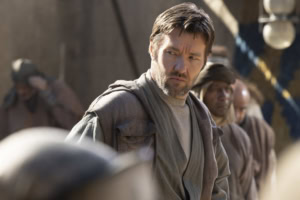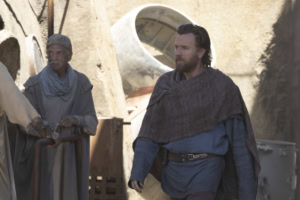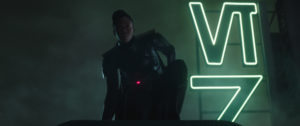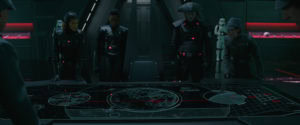By Gary Foss | June 13, 2022
Obi-Wan Kenobi: Suttirat Larlarb
The Star Wars universe quickly became part of the collective landscape. In the decades since many people have written themselves into Joseph Campbell’s monomyth—the broad concept that myths, folk tales, and religious stories from all over the world share unifying themes. Her own hero’s journey brought costume designer Suttirat Larlarb to the project after having honed her craft on projects like American Gods and the latest Bond film, No Time to Die.
Her path to costume design passed through the fine arts and art direction. “In college I studied painting and intended to go into fine arts. I had one costume design class and it definitely more than piqued my interest. It was the synthesis of the things I was interested in like drawing and fashion, of course, but it was also academic incorporating art history, anthropology, and psychology. Building a world through research and creativity was a great melding of all the things that I’d been groomed to do.” After graduating she began in the entertainment industry as an art director. “I always knew I was going to end up doing costume. The question was would I do both?”
This fulsome appreciation for world-building and characters is part of what got her the Obi-Wan Kenobi job. Director Deborah Chow had worked on the second season of American Gods. “When we first met she said the way I talked about culture and history as it relates to costume was the clincher for her. She felt that my approach to American Gods would be very similar on Obi-Wan Kenobi uncovering all the cultural stones necessary to create the worlds.”







The Star Wars canon is massive and its visual vocabulary is ingrained in the public imagination. Prepping for such an endeavor was a project of its own. As a product of the ’70s and the influence of a once tight budget, research was like simultaneously prepping a stylized sci-fi and a period piece with overtones of cultural anthropology. “I love studying,” Larlarb enthuses. “I love research. I love being a student. I’d watched the films as a kid, so it’s not like I was a complete blank slate, but when you steep yourself in it deeply it becomes part of your DNA. There was existing canon and certain returning characters, but then stuff that was new. I did very diligent screen grabs. We had boards in the department just focused on footwear or belts or insignia or closures. I found myself and my team understanding what intrinsically ‘felt Star Wars’ and what didn’t.”
This project in particular bridges the space between the dynamism of Ewan MacGregor and the spirit of Alec Guinness. Fidelity to the character while showing the evolution from earlier versions and canonically later incarnation meant balancing that transition while subtly updating the garments for modern eyes. At this point in the overall story, the character is in a unique position. Obi-Wan is hunted and in hiding but still responsible for the fate of the galaxy. “We had to be responsible to that existing culture,” Larlarb elaborates, “but we also have to have something fresh because we’re living in a different world now. The original ’70s trilogy [designed by John Mollo] comes after this series, but this story comes before the late ’90s prequels in the timeline.” To organize the process, she put together reference boards of screen shots from the prequels and ’70s series and broke them into groups. “You can imagine the bad guys and then the bad guys are broken down into their subcategories. It was like a giant Dewey Decimal System of every descriptor you could think of. I can see the ’70s there, even though there is absolutely an inarguable, timeless element to it.”
The distinctions between earlier and later versions of the character can be subtle, but are all the more vital to portray his circumstances and mindset. “We’re finding him at a certain point in his life. Obviously, we need to make him recognizable to fans, but we know what happened at the end of the prequels. He’s a Jedi hiding out in the Star Wars universe. Those things had to sit well with each other. In terms of the storytelling, the idea is that costume is an extension of behavior, so his costume has to do service to all of that.” The differences manifest most in the silhouette and colors the character wore. “He needed to match other residents of that world in clothes of simple construction and in readily available colors. These are the ‘rules’ of dress set forth by the place he’s inhabiting, so he must blend in for our story to make sense.” Another addition was a “woady” [blue] top which contrasts with the more identifiable shades of brown, beige, cream normally associated with the Jedi. “It’s a relatively indistinct for the planet in question, but a rather major gesture for our version of this iconic character.”
Working on the new characters was just as rewarding and given as much meticulous care. “I love the costume we made for Reva [Moses Ingram]. That was a very juicy one to develop and it was one of the first costumes I attended to. We made that mostly all in house. Every single piece started out as a drawing—sketches from me then through costume illustrator Darrell Fuentes, to finally more detailed technical drawings. The workshop with its brilliant makers, a leather master, and our tailor/drapers made the pieces feel like a second skin to her. Her costume is basically versions of black on black, so you really need to break that up with some textural differences. Stacia Lang is a brilliant assistant costume designer who oversaw the build of Moses Ingram’s costume. She’s my right hand and incredibly knowledgeable about nontraditional materials.”







Of course, being involved in such a valuable intellectual property meant staying mum on the details, even when the enthusiasm was close to home. “One of the things that I loved so much about the privilege of working on Obi-Wan Kenobi, is my friends’ kids who can barely contain themselves with excitement. It’s very hard to say, ‘I really can’t say anything….’ My oldest friend has a son who made his own Mandalorian costume while I was working on Obi-Wan Kenobi, and it just got better and better. I thought, ‘Wow, I’m hiring you in this department in a few years….’”
This weighty responsibility was not lost on the cast either. “Every actor came in excited,” Larlarb explains, “but the minute they donned the costume it hit them. It was like handing over the holy grail every time. You could see the little kid in everybody just be like, ‘Wow, I’m wearing a Star Wars costume.’”



